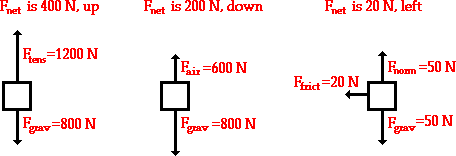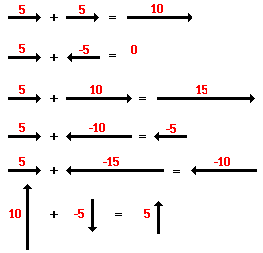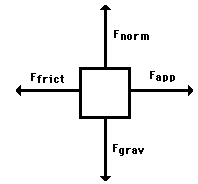
SMKSS Physics' Blog
" Dan diantara kekuasaanNya Dia memperlihatkan kepadamu kilat untuk(menimbulkan) ketakutan dan harapan, dan Dia menurunkan air hujan dari langit, lalu menghidupkan bumi dengan air itu sesudah matinya. Sesungguhnya pada yang demikian itu benar-benar terdapat tanda-tanda bagi kaum yang mempergunakan akalnya."
Tuesday, February 11, 2014
Thursday, June 7, 2012
Determining the net force
Newton's first law of motion states that
An object at rest tends to stay at rest and an object in motion tends to stay in motion with the same speed and in the same direction unless acted upon by an unbalanced force.
In the statement of Newton's first law, the unbalanced force refers to that force that does not become completely balanced (or canceled) by the other individual forces. If either all the vertical forces (up and down) do not cancel each other and/or all horizontal forces do not cancel each other, then an unbalanced force exists. The existence of an unbalanced force for a given situation can be quickly realized by looking at the free-body diagram for that situation. Free-body diagrams for three situations are shown below. Note that the actual magnitudes of the individual forces are indicated on the diagram
Observe in the diagram above that a downward vector will provide a partial or full cancellation of an upward vector. And a leftward vector will provide a partial or full cancellation of a rightward vector. The addition of force vectors can be done in the same manner in order to determine the net force (i.e., the vector sum of all the individual forces). Consider the three situations below in which the net force is determined by summing the individual force vectors that are acting upon the objects.

Aa net force (i.e., an unbalanced force) causes an acceleration.
An object at rest tends to stay at rest and an object in motion tends to stay in motion with the same speed and in the same direction unless acted upon by an unbalanced force.
In the statement of Newton's first law, the unbalanced force refers to that force that does not become completely balanced (or canceled) by the other individual forces. If either all the vertical forces (up and down) do not cancel each other and/or all horizontal forces do not cancel each other, then an unbalanced force exists. The existence of an unbalanced force for a given situation can be quickly realized by looking at the free-body diagram for that situation. Free-body diagrams for three situations are shown below. Note that the actual magnitudes of the individual forces are indicated on the diagram
.
In each of the above situations, there is an unbalanced force. It is commonly said that in each situation there is a net force acting upon the object.
In each of the above situations, there is an unbalanced force. It is commonly said that in each situation there is a net force acting upon the object.
The net force is the vector sum of all the forces that act upon an object.
That is to say, the net force is the sum of all the forces, taking into account the fact that a force is a vector and two forces of equal magnitude and opposite direction will cancel each other out. At this point, the rules for summing vectors (such as force vectors) will be kept relatively simple. Observe
The following examples of the two forces.
:

Observe in the diagram above that a downward vector will provide a partial or full cancellation of an upward vector. And a leftward vector will provide a partial or full cancellation of a rightward vector. The addition of force vectors can be done in the same manner in order to determine the net force (i.e., the vector sum of all the individual forces). Consider the three situations below in which the net force is determined by summing the individual force vectors that are acting upon the objects.

Aa net force (i.e., an unbalanced force) causes an acceleration.
FORCE AND ITS REPRESENTATION
Newton's Laws - Lesson 2
Force and Its Representation
Drawing Free-Body Diagrams

- Free-body diagrams are diagrams used to show the relative magnitude and direction of all forces acting upon an object in a given situation.
- A free-body diagram is a special example of the vector diagrams that were discussed in an earlier unit. These diagrams will be used throughout our study of physics.
- The size of the arrow in a free-body diagram reflects the magnitude of the force.
- The direction of the arrow shows the direction that the force is acting.
- Each force arrow in the diagram is labeled to indicate the exact type of force.
- It is generally customary in a free-body diagram to represent the object by a box and to draw the force arrow from the center of the box outward in the direction that the force is acting.
- An example of a free-body diagram is shown at the right.
The only rule for drawing free-body diagrams is to depict all the forces that exist for that object in the given situation. Thus, to construct free-body diagrams, it is extremely important to know the various types of forces.
If given a description of a physical situation,
- begin by using your understanding of the force types to identify which forces are present.
- Then determine the direction in which each force is acting.
- Finally, draw a box and add arrows for each existing force in the appropriate direction;
- label each force arrow according to its type. If necessary, refer to the list of forces and their description in order to understand the various force types and their appropriate symbols.
Wednesday, June 6, 2012
Applied Forces
|
|
| An applied force is a force that is applied to an object by a person or another object. If a person is pushing a desk across the room, then there is an applied force acting upon the object. The applied force is the force exerted on the desk by the person. |
| The force of gravity is the force with which the earth, moon, or other massively large object attracts another object towards itself. By definition, this is the weight of the object. All objects upon earth experience a force of gravity that is directed "downward" towards the center of the earth. The force of gravity on earth is always equal to the weight of the object as found by the equation:
|
| The normal force is the support force exerted upon an object that is in contact with another stable object. For example, if a book is resting upon a surface, then the surface is exerting an upward force upon the book in order to support the weight of the book. On occasions, a normal force is exerted horizontally between two objects that are in contact with each other. For instance, if a person leans against a wall, the wall pushes horizontally on the person. |
| The friction force is the force exerted by a surface as an object moves across it or makes an effort to move across it. There are at least two types of friction force - sliding and static friction. Thought it is not always the case, the friction force often opposes the motion of an object. For example, if a book slides across the surface of a desk, then the desk exerts a friction force in the opposite direction of its motion. Friction results from the two surfaces being pressed together closely, causing intermolecular attractive forces between molecules of different surfaces. As such, friction depends upon the nature of the two surfaces and upon the degree to which they are pressed together. The maximum amount of friction force that a surface can exert upon an object can be calculated using the formula below: Ffrict = µ • Fnorm The friction force is discussed in more detail later on this page. |
| The air resistance is a special type of frictional force that acts upon objects as they travel through the air. The force of air resistance is often observed to oppose the motion of an object. This force will frequently be neglected due to its negligible magnitude (and due to the fact that it is mathematically difficult to predict its value). It is most noticeable for objects that travel at high speeds (e.g., a skydiver or a downhill skier) or for objects with large surface areas. Air resistance will be discussed in more detail in Lesson 3. |
| The tension force is the force that is transmitted through a string, rope, cable or wire when it is pulled tight by forces acting from opposite ends. The tension force is directed along the length of the wire and pulls equally on the objects on the opposite ends of the wire. |
| The spring force is the force exerted by a compressed or stretched spring upon any object that is attached to it. An object that compresses or stretches a spring is always acted upon by a force that restores the object to its rest or equilibrium position. For most springs (specifically, for those that are said to obey "Hooke's Law"), the magnitude of the force is directly proportional to the amount of stretch or compression of the spring. |
Confusion of Mass and Weight
A few further comments should be added about the single force that is a source of much confusion to many students of physics - the force of gravity.
As mentioned above, the force of gravity acting upon an object is sometimes referred to as the weight of the object. Many students of physics confuse weight with mass.
The mass of an object refers to the amount of matter that is contained by the object; the weight of an object is the force of gravity acting upon that object. Mass is related to how much stuff is there and weight is related to the pull of the Earth (or any other planet) upon thatstuff. The mass of an object (measured in kg) will be the same no matter where in the universe that object is located.
Mass is never altered by location, the pull of gravity, speed or even the existence of other forces. For example, a 2-kg object will have a mass of 2 kg whether it is located on Earth, the moon, or Jupiter; its mass will be 2 kg whether it is moving or not (at least for purposes of our study); and its mass will be 2 kg whether it is being pushed upon or not.
As mentioned above, the force of gravity acting upon an object is sometimes referred to as the weight of the object. Many students of physics confuse weight with mass.
The mass of an object refers to the amount of matter that is contained by the object; the weight of an object is the force of gravity acting upon that object. Mass is related to how much stuff is there and weight is related to the pull of the Earth (or any other planet) upon thatstuff. The mass of an object (measured in kg) will be the same no matter where in the universe that object is located.
Mass is never altered by location, the pull of gravity, speed or even the existence of other forces. For example, a 2-kg object will have a mass of 2 kg whether it is located on Earth, the moon, or Jupiter; its mass will be 2 kg whether it is moving or not (at least for purposes of our study); and its mass will be 2 kg whether it is being pushed upon or not.
On the other hand, the weight of an object (measured in Newton) will vary according to where in the universe the object is.
Weight depends upon which planet is exerting the force and the distance the object is from the planet.
Weight, being equivalent to the force of gravity, is dependent upon the value of g - the gravitational field strength.
On earth's surface gis 9.8 N/kg (often approximated as 10 N/kg). On the moon's surface, g is 1.7 N/kg. Go to another planet, and there will be another g value.
Furthermore, the g value is inversely proportional to the distance from the center of the planet. So if we were to measure g at a distance of 400 km above the earth's surface, then we would find the g value to be less than 9.8 N/kg. (The nature of the force of gravity will be discussed i
n more detail in a later unit of The Physics Classroom.) Always be cautious of the distinction between mass and weight. It is the source of much confusion for many students of physics.
Weight depends upon which planet is exerting the force and the distance the object is from the planet.
Weight, being equivalent to the force of gravity, is dependent upon the value of g - the gravitational field strength.
On earth's surface gis 9.8 N/kg (often approximated as 10 N/kg). On the moon's surface, g is 1.7 N/kg. Go to another planet, and there will be another g value.
Furthermore, the g value is inversely proportional to the distance from the center of the planet. So if we were to measure g at a distance of 400 km above the earth's surface, then we would find the g value to be less than 9.8 N/kg. (The nature of the force of gravity will be discussed i
n more detail in a later unit of The Physics Classroom.) Always be cautious of the distinction between mass and weight. It is the source of much confusion for many students of physics.
Subscribe to:
Posts (Atom)
Labels
- conserve energy (1)
- energy (1)
- paper 3 (1)
- Physics (1)
- physics experiment (1)
- reflection in plane mirror (1)






 Student Extras
Student Extras